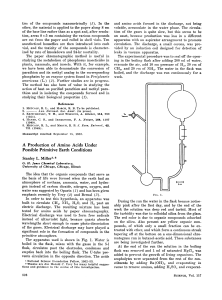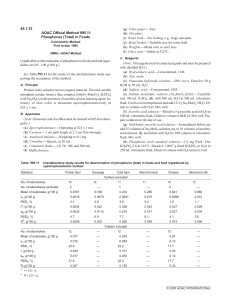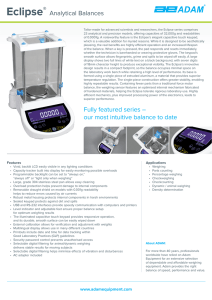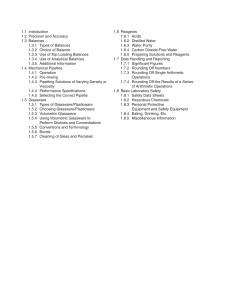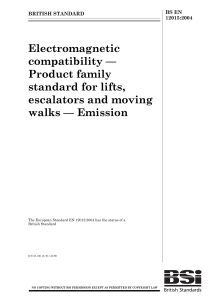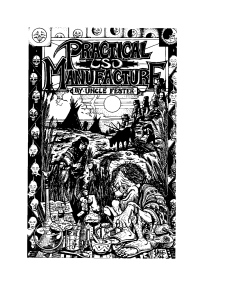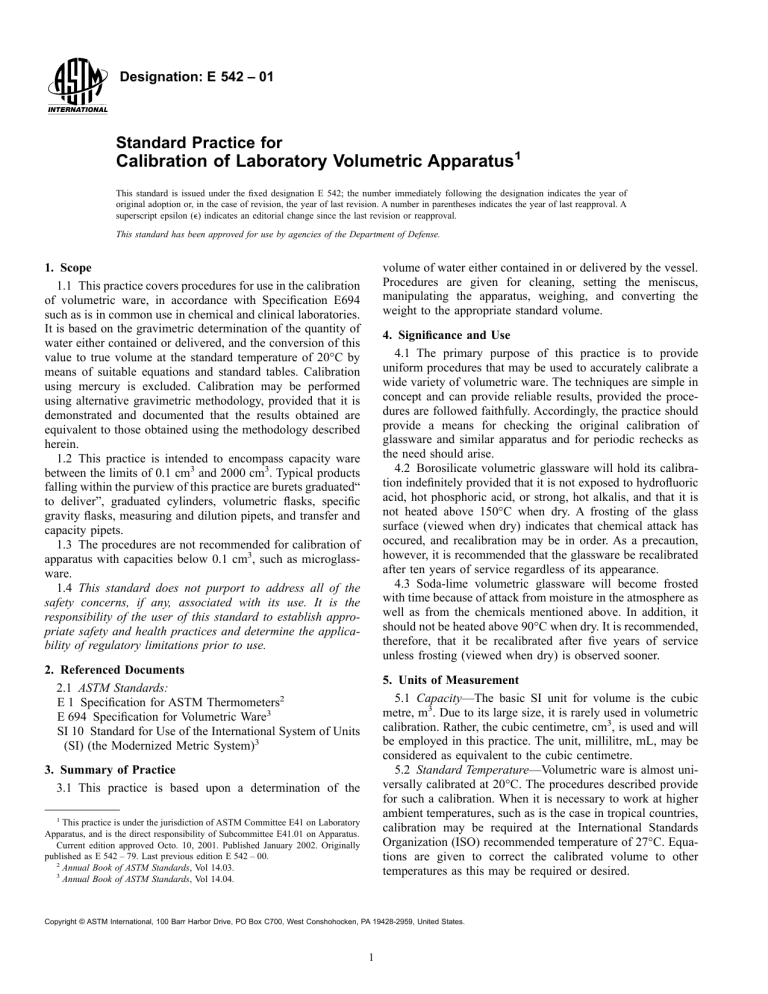
Designation: E 542 – 01 Standard Practice for Calibration of Laboratory Volumetric Apparatus1 This standard is issued under the fixed designation E 542; the number immediately following the designation indicates the year of original adoption or, in the case of revision, the year of last revision. A number in parentheses indicates the year of last reapproval. A superscript epsilon (e) indicates an editorial change since the last revision or reapproval. This standard has been approved for use by agencies of the Department of Defense. volume of water either contained in or delivered by the vessel. Procedures are given for cleaning, setting the meniscus, manipulating the apparatus, weighing, and converting the weight to the appropriate standard volume. 1. Scope 1.1 This practice covers procedures for use in the calibration of volumetric ware, in accordance with Specification E694 such as is in common use in chemical and clinical laboratories. It is based on the gravimetric determination of the quantity of water either contained or delivered, and the conversion of this value to true volume at the standard temperature of 20°C by means of suitable equations and standard tables. Calibration using mercury is excluded. Calibration may be performed using alternative gravimetric methodology, provided that it is demonstrated and documented that the results obtained are equivalent to those obtained using the methodology described herein. 1.2 This practice is intended to encompass capacity ware between the limits of 0.1 cm3 and 2000 cm3. Typical products falling within the purview of this practice are burets graduated“ to deliver”, graduated cylinders, volumetric flasks, specific gravity flasks, measuring and dilution pipets, and transfer and capacity pipets. 1.3 The procedures are not recommended for calibration of apparatus with capacities below 0.1 cm3, such as microglassware. 1.4 This standard does not purport to address all of the safety concerns, if any, associated with its use. It is the responsibility of the user of this standard to establish appropriate safety and health practices and determine the applicability of regulatory limitations prior to use. 4. Significance and Use 4.1 The primary purpose of this practice is to provide uniform procedures that may be used to accurately calibrate a wide variety of volumetric ware. The techniques are simple in concept and can provide reliable results, provided the procedures are followed faithfully. Accordingly, the practice should provide a means for checking the original calibration of glassware and similar apparatus and for periodic rechecks as the need should arise. 4.2 Borosilicate volumetric glassware will hold its calibration indefinitely provided that it is not exposed to hydrofluoric acid, hot phosphoric acid, or strong, hot alkalis, and that it is not heated above 150°C when dry. A frosting of the glass surface (viewed when dry) indicates that chemical attack has occured, and recalibration may be in order. As a precaution, however, it is recommended that the glassware be recalibrated after ten years of service regardless of its appearance. 4.3 Soda-lime volumetric glassware will become frosted with time because of attack from moisture in the atmosphere as well as from the chemicals mentioned above. In addition, it should not be heated above 90°C when dry. It is recommended, therefore, that it be recalibrated after five years of service unless frosting (viewed when dry) is observed sooner. 2. Referenced Documents 2.1 ASTM Standards: E 1 Specification for ASTM Thermometers2 E 694 Specification for Volumetric Ware3 SI 10 Standard for Use of the International System of Units (SI) (the Modernized Metric System)3 5. Units of Measurement 5.1 Capacity—The basic SI unit for volume is the cubic metre, m3. Due to its large size, it is rarely used in volumetric calibration. Rather, the cubic centimetre, cm3, is used and will be employed in this practice. The unit, millilitre, mL, may be considered as equivalent to the cubic centimetre. 5.2 Standard Temperature—Volumetric ware is almost universally calibrated at 20°C. The procedures described provide for such a calibration. When it is necessary to work at higher ambient temperatures, such as is the case in tropical countries, calibration may be required at the International Standards Organization (ISO) recommended temperature of 27°C. Equations are given to correct the calibrated volume to other temperatures as this may be required or desired. 3. Summary of Practice 3.1 This practice is based upon a determination of the 1 This practice is under the jurisdiction of ASTM Committee E41 on Laboratory Apparatus, and is the direct responsibility of Subcommittee E41.01 on Apparatus. Current edition approved Octo. 10, 2001. Published January 2002. Originally published as E 542 – 79. Last previous edition E 542 – 00. 2 Annual Book of ASTM Standards, Vol 14.03. 3 Annual Book of ASTM Standards, Vol 14.04. Copyright © ASTM International, 100 Barr Harbor Drive, PO Box C700, West Conshohocken, PA 19428-2959, United States. 1 E 542 ware should be cleaned in an appropriate manner before calibration. 7.3 Reading and Setting a Liquid Meniscus: 7.3.1 Reading the Meniscus—For all apparatus calibrated by this procedure, the reading is made on the lowest point of the meniscus. In order that the lowest point may be observed, it is necessary to place a shade of some dark material immediately below and behind the meniscus, which renders the profile of the meniscus dark and clearly visible against a light background. A convenient device for this purpose is a collarshaped section of thick black rubber tubing, cut open at one side and of such size as to clasp the tube firmly. Alternatively, black paper may be used. “Short line” graduated vessels where the lines are less than one half of the circumference may be read more accurately by placing a mirror against the rear of the vessel to reflect the front line. 7.3.2 Setting the Meniscus—Setting of the meniscus shall be performed by one of the two methods detailed below. Wherever practical the meniscus should descend to the position of setting. 7.3.2.1 The position of the lowest point of the meniscus with reference to the graduation line is horizontally tangent to the plane of the upper edge of the graduation line. The position of the meniscus is obtained by having the eye in the same plane of the upper edge of the graduation line. 7.3.2.2 The position of the lowest point of the meniscus with reference to the graduation line is such that it is in the plane of the middle of the graduation line. This position of the meniscus is obtained by making the setting in the center of the ellipse formed by the graduation line on the front and the back of the tube as observed by having the eye slightly below the plane of the graduation line. The setting is accurate if, as the eye is raised and the ellipse narrows, the lowest point of the meniscus remains midway between the front and rear portions of the graduation line. By this method it is possible to observe the approach of the meniscus from either above or below the line to its proper setting. 6. Apparatus 6.1 Balance, having sufficient capacity to weigh the loaded vessel. The sensitivity of the balance will be a limiting factor in the accuracy of the measurements. Either a single-pan, direct-reading balance or an equal-arm balance of adequate sensitivity and capacity may be used. In either case the weights must be calibrated with adequate accuracy. Ordinarily, weights with NBS Class S-1 tolerances are required. The balance must have physical dimensions to accept the size of the vessels which need to be weighed. 6.2 Thermometer, for measuring the temperature of the water. The accuracy of this calibration will depend upon the accuracy requirement of the volumetric calibration (see Section 14 for tolerances). 6.3 Barometer, capable of providing atmospheric pressure measurements, consistent with the tolerances given in Section 14. Alternatively, the existing barometric pressure may be obtained from the local weather service. 6.4 Distilled or Deionized Water, suitable for general laboratory purposes. 7. General Considerations 7.1 This section describes manipulative techniques required to obtain accurate and reproducible volumetric measurements. 7.2 Cleaning Procedures: 7.2.1 It is important that volumetric ware be thoroughly cleaned before being tested or used. Glass apparatus must be sufficiently clean to permit uniform wetting of the surface. When clean, the walls will be uniformly wetted and the water will adhere to the glass surface in a continuous film. The clean walls of some plastic apparatus, however, will not be wetted. (Follow the instructions of the manufacturer. Do not use materials which will attack, discolor, or swell the plasticware.) Lack of cleanliness causes irregularities in capacity by distorting the water surface. The liquids usually used for cleaning glassware are sodium dichromatic-sulfuric acid cleaning solution (commercially available from laboratory supply houses), nitric acid, fuming sulfuric acid, alcohol, and water. The choice of cleaning agent to be used depends on the nature of the contaminant. After cleaning with the cleaning solution and thoroughly rinsing with tap water, the vessel should be rinsed with distilled water. 7.2.2 After cleaning, the vessel should be rinsed with ethyl alcohol and dried with clean air at room temperature. It is not necessary to dry any vessel marked “to deliver.” When cleaning small articles such as pipets, it is usually easier to fill them with cleaning solution by suction, using a vacuum line, if available, or a small rubber bulb, but never by mouth. The solution should be drawn through the pipet several times until the entire inside surface is evenly coated. Rinse thoroughly with tap water and then with distilled water. For cleaning flasks, pour in enough cleaning solution while rotating so that a film of solution will cover the entire interior surface. A break in the film indicates a contaminated area. For filling a buret with cleaning solution, it should be held in a vertical position and filled by pouring into the top. Open the stopcock to drain. Regardless of the type of vessel, always rinse thoroughly, first with tap water and then with distilled water. Plastic volumetric NOTE 1—The difference between meniscus positions resulting from the alternative methods of adjustment is the volume equivalent of one half the thickness of the graduation line. In the case of articles where the capacity is read as the difference between two meniscus readings (for example on a buret), then no error results if the article is manufactured using one method of adjustment and is later used by the other method. Even in the most unfavorable cases of single-mark articles (for example large flasks), when working to the highest attainable accuracy, the difference between the two methods of adjustment is unlikely to exceed 30 % of the Class A (precision apparatus) limit of error and a correction can be calculated where necessary. 8. Calibration Procedure for Burets 8.1 Clamp the buret vertically on a support stand; also clamp a plain glass test tube, large enough to hold a thermometer, near the buret if the buret is of such a size that it is not large enough to insert a thermometer in the top for observing the temperature of the water. Fill the buret from a reservoir or storage bottle, in which the water has reached equilibrium with room temperature, and check to verify that there is neither leakage from the tip nor from the stopcock plug. Drain and record the delivery time. Delivery time is determined by the unrestricted outflow of the water from the zero mark to the 2 E 542 and weigh. A pipet or dropper with a finely drawn tip may be used to adjust the meniscus instead of the buret. Determine the temperature by placing a thermometer in the filling beaker or in one which has been filled from the water supply. The temperature may be taken after final weighing by placing a thermometer directly in the flask, provided the flask is of sufficient size to accommodate it. lowest graduation mark with the stopcock fully open. Refill the buret to approximately 10 mm above the zero mark and fill the test tube that holds the thermometer; record the temperature. Set the meniscus on the zero mark using the buret stopcock to lower the liquid level and touch the tip with the wetted wall of a beaker to remove any excess water. A weighing flask that has been tightly stoppered and weighed empty is placed with the inside of the neck in contact with the tip of the buret (the flask will be at a slight angle). 8.2 Fully open the stopcock until the water is only a few millimetres above the line being tested and then the stream is slowed so as to make an accurate setting. When the setting has been completed, move the flask horizontally, breaking the contact with the buret. Recheck the setting. 8.3 Then stopper and weigh the flask a second time, after which refill the thermometer tube and test the next interval in the same manner as the first one—from the zero mark to the next interval needed. 8.4 For burets with a specified waiting time, use the following procedure: after adjustment to the zero mark, fully open the stopcock until the meniscus has reached a position a few millimetres above the graduation line for calibration. After the specified waiting time (for example, 30 s), adjust the meniscus to the graduation line, remove the flask, and weigh. 11. Calibration of Flasks (to Deliver) 11.1 Do not dry flasks that are calibrated to deliver prior to the test. Fill the flask to approximately the index line and empty rapidly by gradually inclining the flask so as to avoid splashing on the walls as much as possible. When the main drainage stream has ceased, the flask will be nearly vertical. Hold in this position for 30 s and touch off the drop of water adhering to the top of the flask. Place a watch glass or plastic cap on the flask to reduce evaporation and weigh immediately. Take a water temperature reading, fill the flask, and make the meniscus setting on the index line, taking care not to splash water on the walls. Place the same cap or watch glass on the filled flask and weigh. The reverse of this procedure may be used, if desirable. 12. Calibration of Other Volumetric Glassware 12.1 Measuring Pipets—Measuring pipets may be calibrated by a similar procedure as described in Section 8, except that the tip must be in contact with the wet wall of a beaker or other vessel when the setting is made on the zero line of a measuring pipet. 12.2 Graduated Cylinders—Volumetric ware of this kind may be calibrated by the procedures described in Sections 10 or 11. 9. Calibration Procedure for Pipets (One Mark) 9.1 Fill the pipet with distilled water by suction to the index mark and measure the delivery time with the tip in contact with the glass surface of the internal side of a beaker. Refill by suction slightly above the index line. Record the temperature of the distilled water in the beaker from which the pipet is filled. Remove any water on the outside of the tip by a downward wipe with filter paper after the filling is completed. Then slowly lower the meniscus to the index using either a stopcock or hose clamp for “fine control.” The tip must be in contact with the wet wall of a beaker while the setting is made on the index line. Do not remove any water remaining on the tip at this time. Hold the pipet in a vertical position and deliver water into a previously weighed weighing flask with the tip in contact with the inside wall of the neck of the flask. After the water has ceased to flow, wait 2 s, then remove the pipet from contact with the flask. The flask is now stoppered and weighed with its contained load. 13. Weighing Procedure 13.1 Two weighings are required, namely IL referring to the loaded vessel, and IE referring to the empty vessel. Normally, IE and IL are observed under the same conditions, hence a precise zero adjustment of the balance is not necessary. Either a single-pan or double-pan balance may be used. For the latter case, during both weighings, place on the opposite pan a vessel, similar to the one being weighed to serve as a tare. Complete both of the required weighings in as short a time interval as convenient to assure that they have been weighed under similar conditions. Record the temperature of the air in the balance case and the barometric pressure for use in subsequent calculations. 13.2 Follow the manufacturer’s instructions in making the requisite measurements. Weighings should be made with care and made expeditiously to minimize evaporation losses which would constitute a source of error. The balance used should be in prime working condition. The vessels that are weighed should be clean externally, and handled carefully to avoid contamination. Vessels may be wiped with a clean cotton cloth as required. Handling with clean cotton gloves is considered to be good practice. 10. Calibration of Flasks (to Contain) 10.1 After cleaning and drying, weigh the empty flask including the stopper. Place an appropriate sized funnel in the flask to discharge the water below the stopper. Fill from beaker or supply line, maneuvering the funnel so as to wet the entire neck below the stopper. Let stand for about 2 min to allow the walls to drain. 10.1.1 After cleaning and drying, weigh the empty flask including the stopper. Place an appropriate sized funnel or other filling device in the flask to discharge the water below the capacity line. Fill from beaker or supply line taking care to avoid wetting neck above capacity line. 10.1.2 Place the flask under a buret and complete filling and setting the meniscus, taking care not to splash water on the walls, after which place stopper in neck to lessen evaporation 14. Calculations 14.1 Calculate the volume from the weight of the water, contained or delivered, as follows: 3 E 542 S 1 V20 5 ~IL 2 IE!~Q! r 2 r w A DS D rA 1 2 r @1 2 a~T 2 20!# B where: (1) Z 5 ~Q! where: IL − IE = the difference, in grams, obtained by subtracting the balance indication in grams associated with the empty weighing flask from that associated with the loaded flask, Q = the apparent mass conversion factor that differs from unity for single-pan, direct-reading balances, depending upon the actual density of the weights and the apparent mass scale to which they have been adjusted by the manufacturer. The factor has a maximum value of 1.000013, hence may be considered as unity for most volumetric calibrations, 1 = two density terms which rerw 2 rA and quire knowledge of air denrA sity, rA, water density, rw, 1 2 r B and the density of the balance weights, rB (density of balance weights taken as 7.78 g/cm3), and 1 − a(T − 20) = the thermal expansion factor used to convert the volume from the temperature of measurement in degrees Celsius, to the standard temperature of 20°C. The symbol a represents the coefficient of cubical expansion of the vessel. 14.2 By multiplying the observed mass of water (IL − IE) by an appropriate Z factor, the volume of the glassware at the standard temperature of 20°C may be obtained. By substituting Z into Eq 1, the equation may be expressed as follows: S S 1 ~ rw 2 rA ! DS D rA 1 2 r @1 2 a~T 2 20!# B (3) Table 1, Table 2, and Table 3 are provided to facilitate the calculation of the volume from the observed weighings for the weighing conditions and practices commonly used. Table 1, Table 2, and Table 3 are applicable when weighings are made with either a single-pan, direct-reading balance or with a double-pan balance with brass weights. 14.2.1 Table 1, Table 2, and Table 3 require a knowledge of the temperature of water at the time of measurement (this is also assumed to be the temperature of the laboratory air) and the barometric pressure. the latter may be measured or obtained from the local weather service. Nominal values may be used, provided it is verified that this will not introduce significant error. The tolerances for the parameters involved in the calculation of V20 are as follows: Parametric Tolerance 6 10 % 6 2.5°C 6 6 mm 6 0.5°C Parameter Relative humidity Air temperature Air pressure Water temperature D D V20 5 ~IL 2 IE! Z S Volumetric Tolerance 1 in 106 1 in 105 1 in 105 1 in 104 14.2.2 It is evident that the measurement of the water temperature is the most critical factor in accurate volumetric calibration. The values of Z from Table 1, Table 2, and Table 3 introduce no errors greater than 2 in 100 000. For more accurate values for weighing conditions not applicable to Table 1 Table 2, and Table 3, Eq 1 should be used with appropriate values of the constants obtained from Appendix X1 of this practice. 14.3 While volumetric glassware is almost universally calibrated at a standard temperature of 20°C, the temperature of use may be different. The calibrated volume for other temperatures may be calculated as follows: VT 5 V20@1 1 a~T 2 20! (4) 14.3.1 For commonly used borosilicate glassware, the correction becomes: VT 5 V20 1 0.00001 V20~T 2 20! (5) 14.3.2 For soda-lime glassware, the correction becomes: VT 5 V20 1 0.000025 V20 ~T 2 20! (6) 14.3.3 Table 5 gives the correction to various observed (2) TABLE 1 Values of Z in Eq 2 as a Function of Temperature and Pressure for Use in Calibration of Type I, Class A, Borosilicate GlassA Barometric Pressure kPa 77.33 79.99 82.66 85.33 87.99 90.66 93.33 95.99 98.66 101.32 103.99 106.66 mbar mm Hg 773 800 827 853 880 907 933 960 987 1013 1040 1067 580 600 620 640 660 680 700 720 740 760 780 800 Temperature,° C 15 16 17 18 19 20 21 22 23 24 25 26 27 28 1.00179 1.00182 1.00184 1.00187 1.00189 1.00192 1.00195 1.00198 1.00201 1.00204 1.00207 1.00209 1.00193 1.00196 1.00199 1.00201 1.00204 1.00207 1.00209 1.00212 1.00215 1.00218 1.00221 1.00224 1.00208 1.00211 1.00214 1.00216 1.00219 1.00222 1.00225 1.00228 1.00230 1.00233 1.00236 1.00239 1.00225 1.00228 1.00231 1.00233 1.00236 1.00239 1.00242 1.00245 1.00247 1.00250 1.00253 1.00256 1.00243 1.00245 1.00248 1.00251 1.00254 1.00256 1.00259 1.00262 1.00265 1.00268 1.00270 1.00273 1.00262 1.00264 1.00267 1.00270 1.00272 1.00275 1.00278 1.00281 1.00284 1.00286 1.00289 1.00291 1.00281 1.00283 1.00287 1.00290 1.00292 1.00295 1.00298 1.00301 1.00304 1.00306 1.00309 1.00312 1.00302 1.00304 1.00308 1.00311 1.00313 1.00316 1.00319 1.00322 1.00324 1.00327 1.00330 1.00333 1.00324 1.00326 1.00330 1.00333 1.00335 1.00338 1.00341 1.00344 1.00346 1.00349 1.00352 1.00355 1.00347 1.00349 1.00353 1.00356 1.00358 1.00361 1.00364 1.00367 1.00370 1.00372 1.00375 1.00378 1.00371 1.00374 1.00377 1.00380 1.00382 1.00385 1.00388 1.00391 1.00393 1.00396 1.00399 1.00402 1.00396 1.00399 1.00402 1.00405 1.00408 1.00410 1.00413 1.00416 1.00418 1.00421 1.00424 1.00427 1.00422 1.00424 1.00428 1.00431 1.00433 1.00436 1.00439 1.00442 1.00444 1.00447 1.00450 1.00452 1.00449 1.00451 1.00455 1.00458 1.00460 1.00463 1.00466 1.00468 1.00471 1.00474 1.00477 1.00479 A Values of Z assume a relative humidity of 50 %. 4 E 542 TABLE 2 Values of Z in Eq 2 as a Function of Temperature and Pressure for Use in Calibration of Type II, Soda-Lime GlassA Barometric Pressure kPa mbar mm Hg Temperature,° C 15 16 17 18 19 20 21 22 23 24 25 26 27 28 77.33 79.99 82.66 85.33 87.99 90.66 93.33 773 800 827 853 880 907 933 580 600 620 640 660 680 700 1.00186 1.00189 1.00192 1.00194 1.00196 1.00199 1.00202 1.00199 1.00202 1.00205 1.00207 1.00210 1.00213 1.00215 1.00212 1.00215 1.00218 1.00220 1.00223 1.00226 1.00229 1.00228 1.00231 1.00234 1.00236 1.00239 1.00242 1.00245 1.00244 1.00246 1.00250 1.00253 1.00256 1.00258 1.00261 1.00262 1.00264 1.00267 1.00270 1.00272 1.00275 1.00278 1.00279 1.00281 1.00285 1.00288 1.00290 1.00293 1.00296 1.00299 1.00301 1.00305 1.00308 1.00310 1.00313 1.00316 1.00319 1.00321 1.00326 1.00328 1.00330 1.00333 1.00336 1.00341 1.00343 1.00347 1.00350 1.00352 1.00355 1.00357 1.00363 1.00366 1.00369 1.00372 1.00374 1.00377 1.00380 1.00387 1.00390 1.00393 1.00396 1.00399 1.00401 1.00404 1.00411 1.00414 1.00417 1.00420 1.00422 1.00425 1.00428 1.00437 1.00439 1.00443 1.00446 1.00448 1.00451 1.00454 95.99 98.66 101.32 103.99 106.66 960 987 1013 1040 1067 720 740 760 780 800 1.00205 1.00208 1.00212 1.00214 1.00216 1.00218 1.00221 1.00224 1.00227 1.00230 1.00232 1.00234 1.00237 1.00240 1.00243 1.00248 1.00250 1.00253 1.00256 1.00259 1.00264 1.00267 1.00270 1.00272 1.00275 1.00281 1.00284 1.00286 1.00289 1.00291 1.00299 1.00302 1.00304 1.00307 1.00310 1.00319 1.00321 1.00324 1.00327 1.00330 1.00339 1.00341 1.00344 1.00347 1.00350 1.00361 1.00364 1.00366 1.00369 1.00372 1.00383 1.00385 1.00388 1.00391 1.00394 1.00407 1.00409 1.00412 1.00415 1.00418 1.00431 1.00433 1.00436 1.00439 1.00441 1.00456 1.00459 1.00462 1.00465 1.00467 A Values of Z assume a relative humidity of 50 %. TABLE 3 Values of Z in Eq 2 as a Function of Temperature and Pressure for Use in Calibration of Type I, Class B, Borosilicate GlassA Barometric Pressure kPa 77.33 79.99 82.66 85.33 87.99 90.66 93.33 95.99 98.66 101.32 103.99 106.66 mbar mm Hg 773 800 827 853 880 907 933 960 987 1013 1040 1067 580 600 620 640 660 680 700 720 740 760 780 800 Temperature,° C 15 16 17 18 19 20 21 22 23 24 25 26 27 28 1.00182 1.00184 1.00186 1.00190 1.00192 1.00195 1.00198 1.00200 1.00204 1.00206 1.00209 1.00212 1.00195 1.00198 1.00201 1.00203 1.00206 1.00209 1.00211 1.00215 1.00217 1.00220 1.00223 1.00226 1.00210 1.00212 1.00215 1.00218 1.00221 1.00224 1.00226 1.00229 1.00232 1.00235 1.00238 1.00240 1.00226 1.00229 1.00232 1.00234 1.00237 1.00240 1.00243 1.00246 1.00248 1.00251 1.00254 1.00257 1.00243 1.00246 1.00249 1.00251 1.00254 1.00257 1.00259 1.00262 1.00266 1.00268 1.00271 1.00273 1.00262 1.00265 1.00267 1.00270 1.00272 1.00275 1.00278 1.00281 1.00284 1.00286 1.00289 1.00292 1.00281 1.00284 1.00287 1.00289 1.00292 1.00295 1.00298 1.00301 1.00303 1.00306 1.00309 1.00311 1.00302 1.00304 1.00307 1.00310 1.00312 1.00316 1.00318 1.00321 1.00324 1.00326 1.00329 1.00331 1.00323 1.00326 1.00328 1.00331 1.00334 1.00337 1.00340 1.00342 1.00345 1.00348 1.00350 1.00353 1.00346 1.00348 1.00351 1.00354 1.00357 1.00359 1.00362 1.00365 1.00367 1.00370 1.00373 1.00375 1.00370 1.00372 1.00375 1.00378 1.00380 1.00383 1.00386 1.00389 1.00391 1.00393 1.00397 1.00399 1.00394 1.00397 1.00399 1.00402 1.00405 1.00407 1.00410 1.00413 1.00415 1.00418 1.00421 1.00424 1.00420 1.00422 1.00425 1.00427 1.00430 1.00433 1.00435 1.00438 1.00441 1.00444 1.00447 1.00449 1.00447 1.00448 1.00451 1.00454 1.00456 1.00459 1.00461 1.00464 1.00467 1.00470 1.00473 1.00476 A Values of Z assume a relative humidity of 50 %. TABLE 4 Precision Data volumes of water, measured at the designated temperatures, to give the volume at the standard temperature, 20°C. Conversely, by subtracting the corrections from the volume desired at 20°C, the volume that must be measured at the designated temperatures in order to give the desired volume at 20°C will be obtained. It is assumed that the volumes are measured in glass apparatus having a coefficient of cubical expansion of 0.000025 per° C. The table is applicable to dilute aqueous solutions having the same coefficient of expansion as water. Table 6 gives temperature corrections for water, when measured in borosilicate glass apparatus having a coefficient of cubical expansion of 0.000010 per °C. Nominal Size, cm3 Reproducibility, cm3A 1 2 5 10 15 25 50 100 0.002 0.002 0.002 0.003 0.005 0.005 0.007 0.010 Flasks 10 25 50 100 200 250 500 1000 0.005 0.005 0.007 0.011 0.014 0.017 0.021 0.042 Burets 10 25 50 100 0.003 0.005 0.007 0.012 Vessel Transfer Pipet 15. Precision 15.1 Experience has shown that a competent operator should be able to repeat volumetric calibrations within the limits indicated in Table 4. 15.2 The largest source of experimental error associated with this measurement is in the adjustment of the meniscus, which will depend on operator care and is related to the cross section of the tubing where the meniscus is located. Some typical values are given in Table 5. 15.3 Bias—The procedure in this practice for determining volume has no bias because the volume is determined only in terms of this procedure. A The term “reproducibility” refers to the maximum difference expected between two independent determinations of volume. 16. Keywords 16.1 apparatus; calibration; laboratory; volumetric 5 E 542 TABLE 5 Temperature Corrections for Water Measured in Soft Glass Apparatus Having a Coefficient of Cubical Expansion of 0.000025/°C Capacity of Apparatus in Millilitres at 20°C Temperature of Measurement (°C) 2 000 1 000 15 16 17 18 19 21 22 23 24 25 26 27 28 29 30 +1.54 +1.28 +0.99 +0.68 +0.35 −0.37 −0.77 −1.18 −1.61 −2.07 −2.54 −3.03 −3.55 −4.08 −4.62 +0.77 +0.64 +0.50 +0.34 +0.18 −0.18 −0.38 −0.59 −0.81 −1.03 −1.27 −1.52 −1.77 −2.04 −2.31 500 400 300 Correction in millilitres to give volume of water at 20°C +0.38 +0.32 +0.25 +0.17 +0.09 −0.09 −0.19 −0.30 −0.40 −0.52 −0.64 −0.76 −0.89 −1.02 −1.16 +0.31 +0.26 +0.20 +0.14 +0.07 −0.07 −0.15 −0.24 −0.32 −0.41 −0.51 −0.61 −0.71 −0.82 −0.92 +0.23 +0.19 +0.15 +0.10 +0.05 −0.06 −0.12 −0.18 −0.24 −0.31 −0.38 −0.46 −0.53 −0.61 −0.69 250 150 +0.19 +0.16 +0.12 +0.08 +0.04 −0.05 −0.10 −0.15 −0.20 −0.26 −0.32 −0.38 −0.44 −0.51 −0.58 +0.12 +0.10 +0.07 +0.05 +0.03 −0.03 −0.06 −0.09 −0.12 −0.15 −0.19 −0.23 −0.27 −0.31 −0.35 TABLE 6 Temperature Corrections for Water Measured in Borosilicate Glass Apparatus Having a Coefficient of Cubical Expansion of 0.000010/°CA Temperature of Measurement (°C) 15 16 17 18 19 21 22 23 24 25 26 27 28 29 30 Capacity of Apparatus in Millilitres at 20°C 2 000 1 000 +1.69 +1.39 +1.08 +0.74 +0.38 −0.40 −0.83 −1.27 −1.73 −2.22 −2.72 −3.24 −3.79 −4.34 −4.92 +0.84 +0.70 +0.54 +0.37 +0.19 −0.20 −0.41 −0.64 −0.87 −1.11 −1.36 −1.62 −1.89 −2.17 −2.46 500 400 300 Correction in millilitres to give volume of water at 20°C +0.42 +0.35 +0.27 +0.19 +0.10 −0.10 −0.21 −0.32 −0.43 −0.55 −0.68 −0.81 −0.95 −1.09 −1.23 +0.34 +0.28 +0.22 +0.15 +0.08 −0.08 −0.17 −0.25 −0.35 −0.44 −0.54 −0.65 −0.76 −0.87 −0.98 +0.25 +0.21 +0.16 +0.11 +0.06 −0.06 −0.12 −0.19 −0.26 −0.33 −0.41 −0.49 −0.57 −0.65 −0.74 250 150 +0.21 +0.17 +0.13 +0.09 +0.05 −0.05 −0.10 −0.16 −0.22 −0.28 −0.34 −0.41 −0.47 −0.54 −0.62 +0.13 +0.10 +0.08 +0.06 +0.03 −0.03 −0.06 −0.10 −0.13 −0.17 −0.20 −0.24 −0.28 −0.33 −0.37 A In using the above tables to correct the volume of certain standard solutions to 20°C, more accurate results will be obtained if the numerical values of the corrections are increased by the following percentages: Normality Solution HNO3 H2SO4 NaOH KOH N N/2 N/10 50 45 40 40 25 25 25 20 6 5 5 4 APPENDIX (Nonmandatory Information) X1. ADDITIONAL FACTORS USED IN CALIBRATING VOLUMETRIC GLASSWARE REFERENCES (1) Hughes, J. C., “Testing of Glass Volumetric Apparatus,” NBS Circular 602, National Bureau of Standards, April 1959, Washington, D.C. 20234. (2) Lembeck, J., “The Calibration of Small Laboratory Glassware,” NBSIR 74-461, December 1974, National Bureau of Standards, Washington, D.C. 20234. (3) Pontius, P. E., “Mass and Mass Values,” NBS Monograph 133, National Bureau of Standards, 1974. (4) Taylor, J. K., “Measurement of Density and Specific Gravity,” Treatise on Analytical Chemistry, edited by I. M. Koltholl and P. J. Elving, Interscience Publishers, New York, N.Y., Part I, Vol 7, 1967, pp. 4561–4610. 6 E 542 TABLE X1.1 Density of Air-Free Water, rw Temperature, °C Density, g/cm3 15 16 17 18 19 20 21 22 23 24 25 26 27 28 29 30 31 32 33 34 35 0.999098 0.998941 0.998773 0.998593 0.998403 0.998202 0.997990 0.997768 0.997536 0.997294 0.997043 0.996782 0.996511 0.996232 0.995943 0.995645 0.995339 0.995024 0.994701 0.994369 0.994030 TABLE X1.2 Density of Air, rA, in g/cm3 A Barometric Pressure Temperature,° C kPa mbar mm Hg 15 16 17 18 20 22 24 26 28 77.33 79.99 82.66 85.33 87.99 90.66 93.33 95.99 98.66 101.32 103.99 106.66 773 800 827 853 880 907 933 960 987 1013 1040 1067 580 600 620 640 660 680 700 720 740 760 780 800 0.00094 0.00097 0.00100 0.00103 0.00106 0.00110 0.00113 0.00116 0.00119 0.00123 0.00126 0.00129 0.00093 0.00096 0.00100 0.00103 0.00106 0.00109 0.00112 0.00116 0.00119 0.00122 0.00125 0.00128 0.00093 0.00096 0.00099 0.00102 0.00105 0.00109 0.00112 0.00115 0.00118 0.00122 0.00125 0.00128 0.00092 0.00095 0.00099 0.00102 0.00105 0.00108 0.00111 0.00114 0.00118 0.00121 0.00124 0.00127 0.00092 0.00095 0.00098 0.00101 0.00104 0.00107 0.00110 0.00114 0.00117 0.00120 0.00123 0.00126 0.00091 0.00094 0.00097 0.00100 0.00103 0.00107 0.00110 0.00113 0.00116 0.00119 0.00122 0.00125 0.00091 0.00093 0.00096 0.00100 0.00103 0.00106 0.00109 0.00112 0.00115 0.00118 0.00121 0.00124 0.00090 0.00093 0.00096 0.00099 0.00102 0.00105 0.00108 0.00112 0.00114 0.00117 0.00121 0.00124 0.00090 0.00092 0.00095 0.00098 0.00101 0.00104 0.00107 0.00110 0.00113 0.00117 0.00120 0.00123 A Computed for air at 50 % relative humidity. TABLE X1.3 Coefficient of Cubical Expansion of Materials Commonly Used in Laboratory Ware cm3/° C Material Fused silica (quartz) Borosilicate glass (Type I, Class A) Borosilicate glass (Type I, Class B) Soda-lime glass Polypropylene plastic Polycarbonate plastic Polystyrene plastic 0.0000016 0.000010 0.000015 0.000025 0.000240 0.000450 0.000210 ASTM International takes no position respecting the validity of any patent rights asserted in connection with any item mentioned in this standard. Users of this standard are expressly advised that determination of the validity of any such patent rights, and the risk of infringement of such rights, are entirely their own responsibility. This standard is subject to revision at any time by the responsible technical committee and must be reviewed every five years and if not revised, either reapproved or withdrawn. Your comments are invited either for revision of this standard or for additional standards and should be addressed to ASTM International Headquarters. Your comments will receive careful consideration at a meeting of the responsible technical committee, which you may attend. If you feel that your comments have not received a fair hearing you should make your views known to the ASTM Committee on Standards, at the address shown below. This standard is copyrighted by ASTM International, 100 Barr Harbor Drive, PO Box C700, West Conshohocken, PA 19428-2959, United States. Individual reprints (single or multiple copies) of this standard may be obtained by contacting ASTM at the above address or at 610-832-9585 (phone), 610-832-9555 (fax), or [email protected] (e-mail); or through the ASTM website (www.astm.org). 7
